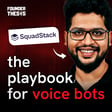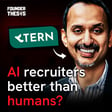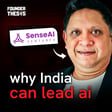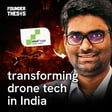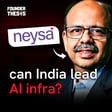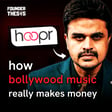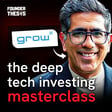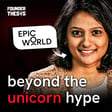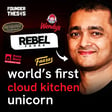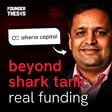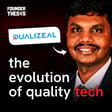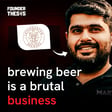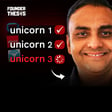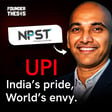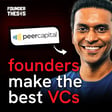Introduction to the Founder Thesis Podcast
00:00:01
Speaker
Let's take a look at the video. Let's get started. Hi, I'm Akshay. Hi, this is Aurabh. And you are listening to the founder thesis podcast. We meet some of the most celebrated sort of founders in the country. And we want to learn how to build a unicorn.
Impact of Startups on Urban Lifestyles
00:00:29
Speaker
Some of the best-known start-ups like Zomato and Swiggy are making the most impact in the lives of people living in cities. Life has never been easier for the kind of people who listen to this podcast.
00:00:42
Speaker
But what about the people living in millions of villages in India who are not tech savvy and lack access to basic infrastructure?
Dehaat: An Amazon for Farmers?
00:00:50
Speaker
We are proud to present to you today a conversation with a founder who is building an Amazon for farmers. Sashank Kumar is the founder of Dehat and coming from a farming community, he has a first-hand understanding of the problems faced by this segment.
00:01:05
Speaker
What he's building at Dehaat is an everything store for farmers, from where farmers can buy pretty much anything they need as an input, including financial services like insurance and loans. And once the farmer is ready to sell his product, he can also sell it at his local Dehaat store at a fair and transparent price. And on top of that, farmers get access to content and guidance to help them manage their crops better.
00:01:32
Speaker
Here's Shashank telling Akshay Dutt about
Sashank Kumar's Journey from Rural to IIT
00:01:35
Speaker
Deha. Shashank, you grew up in a village in Bihar. Tell me what was that like? Yeah, so that was the starting phase of my life. And again, I belong to a place called Chapra. It's a small town nearly 80 kilometers far from the state capital, Patna. Initial seven, eight years of my life I spent in rural semi-urban setup.
00:01:58
Speaker
So was it like a pretty standard thing for people to pursue an IIT as a path there, like to aim for the entrance exam? Not really. It was quite diverse all across, right? From science to medical background, and a lot of students used to opt for literature. What made you want to do IIT, like pursue engineering? Honestly speaking, I mean, once in my village, someone said that
00:02:28
Speaker
IITs make a lot of money. They get good salary. Yeah. So that's how I heard about IIT world very first time in my life. And you know, tell me about that transition into IIT now. It was a complete transition for sure. I mean, because from a sort of, you know, boarding or boarding school to again,
00:02:58
Speaker
IIT and that too in a city like Delhi. And transition because it was a more competitive world, right? And it was way faster than, of course, what we had seen, whether in my hometown or in that school, for that matter. And again, obviously, needless to say, there were people with bigger dreams. But more importantly, in fact, at the same time, in fact, many people with a lot of exposure
00:03:27
Speaker
Right. I mean, for a while, I mean, on a candid note, like when in my case, when I cleared IIT, I thought that now I think everything I've achieved in my life.
The Start of Sashank's Entrepreneurial Spirit
00:03:37
Speaker
Right. And I think that used to be notion. Right. Because in your village or in your district, people used to say that if you once you are into IIT, then you are done in your life. Right. So so that was like the same state of mind for me.
00:03:50
Speaker
But then it took me one or two semester to understand that no, it's just a new beginning. So you became pretty outgoing during those four years. Absolutely. Absolutely. Where did you get placed through campus then? So I got placed in a in a startup in a management consulting startup company called Beacon. What kind of consulting was the offering?
00:04:13
Speaker
Well, it was a pure strategy and management consulting role in a specific domain of supply chain, retail, FMCG. So these guys must have been from that FMCG and retail industry. Absolutely. I think before they started this venture, they worked with the P&G, Unilever, and that's where basically they founded TriggerPoint. So how did that beacon stint lead you to become an entrepreneur?
00:04:44
Speaker
Oh, a lot. Because obviously, I mean, technically, I was the first employee of Beacon. And of course, although I was quite junior to them, but still being from same college, obviously, it brings a different degree of comfort with each other. So somehow, in such a short span of two and a half years, in fact,
00:05:13
Speaker
I mean, when you had so many projects, then sort of, you know, financial crisis, when few projects basically, again, I mean, people backed off, and still as an entrepreneur, in fact, you know, you are now running the company with a high speed, you're fighting. So that really helped me. And I think that, and but at the same time,
00:05:36
Speaker
2008 to 10. That was the time when at least in India, we started hearing the word called startups or entrepreneurship, right? Yeah, Flipkart was there. Jabong was started. Books of Rashmi Bansal were out on the shelf.
00:05:58
Speaker
So it's a good career path, right? I mean, why to? And somehow it was a default sitting in me to not to follow the standard template, right? I mean, something what I sort of realized when I decided to join a startup rather than going for a sort of any large form or so. So then again, the same thought process that, all right, I mean, it's fine that two, two and a half years of, you know,
00:06:24
Speaker
While my peers, in fact, are trying to write GMAT or CAT, I mean, let's think about this startup bit, right? Because from your inner side, I think this is something which is really exciting you. And then more importantly, I had that two and a half years of experience of working very closely with first generation entrepreneurs or so. So then, passionately, I started exploring different ideas for my own startup.
00:06:52
Speaker
So, how did you finalize, like, you know, tell me that journey of leaving a job and becoming a founder? So, okay. So, when I found this soft corner towards entrepreneurship, so right from that day, you know, started exploring voltage-voltage ideas. At the same time,
00:07:13
Speaker
I think my family background, I think that is something which really made me worry. That says you are not from business background, there is no experience. So more importantly, that fear of failure or some sort of risk-taking ability, I mean, not having risk-taking ability, I think somehow I believe that that was in my blood or in my background.
00:07:40
Speaker
So again, I mean, while exploring different ideas to think or to work, I really worked hard to graduate myself as an entrepreneur. So for example, during weekends, I used to go to Chandni Chok, Chawari, Sadhar Bazar, which is the wholesale market of Delhi and NCR. I mean, just to see how people operate and how does the core business in fact look like, right?
00:08:09
Speaker
At the same time, I tried to
00:08:11
Speaker
you know, talk to as many people as possible. All the veterans, like, again, Sanjeev each and any of, you know, knockery or different people, of course, you just like sent him an email or something that I want to talk. I used to keep a close track. Because again, as I said that because of that, early signs of entrepreneurial ecosystem or evolving our ecosystem, I mean, all the colleges, in fact, they started, you know, organizing these talks.
00:08:42
Speaker
So, and I was just out of college. I had, I mean, I had good repo, you know, among my junior side. I used to tell them, Hey, so whenever any entrepreneur is coming for talk, I'm going to keep you posted. So, or, or wherever I found any opportunity. So, so, so, yeah. And, and then after, and then at the same time again, when you are into job and that too, in consulting, right? I mean, then.
00:09:07
Speaker
you don't really care about your cost, your expenses, right? Because very first time in your life, I mean, you're actually getting good money, right? So then also cutting down your expenses and those stuff, right? I mean, so it took me one good year to
00:09:25
Speaker
to again, to certify myself as a prospective entrepreneur,
Focusing on Agriculture: A Strategic Decision?
00:09:30
Speaker
right? I mean, after visiting infinite visits to different markets, meeting different people, reading a lot of books, cutting down expenses, I mean, some sort of, you know, like more sort of, you know, working on yourself, rather than the idea for that matter.
00:09:48
Speaker
And then along with that again obviously what would be the idea for which let's say I can give my rest of my life again I mean that was again a parallel exercise altogether. So what was that idea which you wanted to explore deeply?
00:10:02
Speaker
I explored many ideas. One of the ideas was to work with health workers or maybe to aggregate auto rickshawala. Because those days, of course, even that place, that space was highly throw-off in our structure. There was no Ola, there was no Jugno at that point of time. But you knew about Uber. The concept of aggregation was there. Concept of aggregation was there, but honestly speaking, I didn't know about Uber at that point of time.
00:10:32
Speaker
And then suddenly, again, it boils down to agree. And primarily because of when I think in a retrospect manner, I think because of multiple reasons, because by that time, I got exposed to both the ends of food chain. Obviously, one, my family background or the farming background during initial seven years of my life. And secondly, during my consulting stint, I got a chance to work with all these FNCG players, whether it's
00:10:59
Speaker
Unilevers or PepsiCo or Britannia or mother really or so. So of course, I mean, and with the getting exposed to both the ends of food chain, at least I could understand the gaps of this entire agriculture supply chain and by or at least facts of facts that one side farmers are not happy with the return. And at the same time, these companies are struggling too. And then at the same time, when I double clicked,
00:11:27
Speaker
And then the numbers I came across, those numbers were mind boggling in terms of having more than 100 billion farmers in India, or the overall time or the market size as more than $350 billion or so. So that time, probably 50% of India's economy was agriculture, I guess.
00:11:46
Speaker
It was 15.15% GDP contribution, even as a rate that's close to 14% or so. But more importantly, I could understand that it's a large market. No one else is doing.
00:12:03
Speaker
And again, the theme sort of in a thought process that hey, it's not that standard template, like nobody else is doing that I should I must do this, right? It was more of that default setting. And then at the same time, by that time, I could, I could realize the strength in myself, and which was having a great interpersonal skill. What was your plan? Like, like you wanted to be like a
00:12:31
Speaker
like a B2B company which procures from farmers and supplies to like the unilevers and the nestlers of the world. Was that the idea? That was the idea for sure. But that was never the plan even for a single day. Because that was definitely the idea. That was a trigger point to start thinking about the sector.
00:12:56
Speaker
But then we met a lot of farmers of different regions. My base was in Gurgaon, so again I used to travel towards some time Rajasthan, maybe Haridwar, Saeed, or maybe PR, or UP, and then interacted with more than 1000 farmers again over 6-7 months or so.
00:13:15
Speaker
And then while holding down a job, like on weekends you would travel and be farmers.
Building Dehaat's Comprehensive Support Model
00:13:23
Speaker
Absolutely. And then realize that this market linkage or the optic part, that's not the only problem farmers are facing. Their actual problem begins in the beginning of the season itself, which crop to grow, how to grow, agri-import, or there are a lot of challenges they have to go through.
00:13:44
Speaker
And again, that's how this model of supporting the farmer throughout the season with the end-to-end proposition, I think that was the idea since the beginning. But more importantly, initially it was just a thought
00:14:03
Speaker
you know, actually to do something in Ag, so that you can bring transparency, so that you can aggregate more and more farmers to change their life. I think that was the idea. Model, it was not clear, right? I mean, and I strongly believe that, you know, I was fortunate to have this approach in my life.
00:14:25
Speaker
right? I mean, because there was no model, despite of being consultant, but there was no Excel sheet, there was no Word doc, no PPT or business plan. It was just a part that can you bring a change in this sector? And that's how it all started. So what was like version one of what you launched, like version one product? So our version one was, I would say,
00:14:54
Speaker
Even though there was no version one with which we started, right? I mean, we definitely, for example, when I felt that now I'm ready to take this plunge, in fact, I quit, I resigned. By that time, in fact, and then at the same time from day zero, started building a core founding team.
00:15:13
Speaker
And that's how basically, you know, got to know a few friends, a habit of talking to as many people as possible. And in that process, basically, you know, you've got a few folks to join you and your thought process. That was another sort of key. Join as co-founders or as employees? No, no, co-founders. Okay. Yeah. And who has joined them? Like, what was the founding team?
00:15:39
Speaker
So very old friend of mine, Manish, we prepared for IIT together.
00:15:46
Speaker
And then another friend, Shyam. So these two folks, in fact, they got interested. When I went ahead, in fact, I found two, three more folks, in fact, Amrit Indra, whom I didn't know earlier. But somehow he got to know that he's doing something in Agri and he was passionate by himself to do something in Ag, similarly others and Abhishek. And that's how, again, six of us somehow came together.
00:16:17
Speaker
It's a pretty large founding team. By that time, there was no model. That's why I would say that there was no version one. I think version one or version one of Dehaaz was building a founding team.
00:16:36
Speaker
in a for a for a for a goal right and goal was to again to build a large no sustainable business model around farmers. Talk me through the model what exactly is it like you first go to a farmer and the model was that you know that hey so can we bring businesses and farmers together in a transparent way in a controlled way.
00:16:58
Speaker
And then while connecting farmers to different businesses, whether it's input companies or banks or financial institutions or market, effectively, as a platform, you intend or you want to provide everything under one roof for agriculture to farmers in an accessible as well as affordable way. So tell me about your go-to market then. You must have built some set of services through some alliances in some
00:17:27
Speaker
format which may be as an annual subscription or for a farmer or like you know what was it? Our go-to market was fairly simple for the farmers that hey so we are sort of in a one-stop solution for you whichever crop you are growing you will get every input advisory and market linkage you know through this platform
00:17:49
Speaker
Secondly, since you are a small farmer, that means your number of transactions is very high, but the ticket size of transactions is very small. And we are not just into information exchange. We are talking about actual supply chain linkage, whether it's input or output.
00:18:08
Speaker
So all these services are really accessible for you. So for example, if you want to sell the produce, you don't have to travel 40 kilometer or either for the transaction. So the heart center is close to your farm gate within three to five kilometer area. That's where you can come. You can deposit your material. You can buy your seeds. And for advisory, again, you all have mobile phones. So we are, again, we'll call you and we'll provide you customized advisory.
00:18:38
Speaker
Like that's what I'm trying to understand. It's actually physical as well as digital both. Because the farmers, either they download the app. At that stage, it must have been more physical, right? Oh, at that stage, it was all physical. It was all manual. It was all manual. In fact, first to the house store or the house centers, we operated by ourselves for 13, 40 months. So those days, it was all... Where did you open the first sentence? Like, tell me about that first sentence.
00:19:08
Speaker
Well, it was in Vaishali district of Bihar and again there is a story.
Expansion and Scalability of Dehaat
00:19:18
Speaker
We did not have any store.
00:19:21
Speaker
But we started operating, we started working with farmers who were excited to hear about our plan. At the same time, they had some fear too, because, I mean, like 26, 25 years old kids, no agricultural background, right? I mean, and they are asking us to change what they have been doing. So, but still, again, I mean, because of persistent effort, few of the farmers, in fact, they enrolled themselves.
00:19:49
Speaker
And more importantly, they realized that there is no high opportunity cost because for advisory, they are not charging or agree input when we will purchase, we will pay. And for agree output, they will pay when they will purchase. So as such, there is no risk involved. And when was this, the first sentence? Month and year, if you remember? It was in 2013.
00:20:17
Speaker
Okay. And you called it Dehaat then? When did you call the name? No. So the name Dehaat, it came in 2014. And again, because our registered name is Green Ag Revolution Private Limited.
00:20:35
Speaker
Of course, it was way too English for any farmer. Since 2013 to 2014, we had four or five centers by that time in different localities. Without that note, let's pick a name which will be easier for farmers to call or recall. That's how, again, I mean, they had as a name, it came into the picture.
00:21:04
Speaker
Okay and so like first year how many farmers did you sign up like you know who
00:21:11
Speaker
So, in the first two Dehaat centers, as I mentioned, we operated by ourselves for 13-14 months and by that, we already passed. Like, six or three split up, like three on one and three on the other centers, something like that. Again, at that point in time, all six of us were not there because, as I said, Shyam was in college. I mean, of course, a few of us, in fact, we got connected later. But Amre and I, in fact, we were there.
00:21:37
Speaker
So at that point of time, just three of us were there on ground. 952,000 farmers, in fact, they were already kind of associated with those two health centers. And that was, again, another kick for us that things are moving in the right direction. Let's have more than one health centers.
00:21:56
Speaker
Yeah, Thagun is a pretty substantial number, yeah. And the second center was soon after the first one, like how much gap? Very soon. I mean, next season, right next season. And in fact, again, in farmers community, word of mouth, that plays the most important role, right? So then the local farmers, in fact, they
00:22:16
Speaker
they started spreading the word. And in fact, they themselves, you know, started shortlisting someone from the same community who can run your center, in fact, if you help them. Okay, yeah. So actually, we learned, for example, for your information, there's the heart center, which is a which is a franchise network today. So we actually learned from the farmers themselves, right? I mean, because we were still thinking that, hey, so whether we should have
00:22:43
Speaker
company-owned, company-operated centers, or we should go for a franchisee. But by the time we would have thought, in fact, we had four or five prospective candidates in front of us. And at the same time, there was a pressure from the community that, hey, so you have to start the heart center in our operating area. So we were forced to, again, adopt this franchise approach. But again, at the same time, we did our deeper research. And again, by
00:23:12
Speaker
2013, there were many evidences around this microentrepreneur program. I mean, whether it's a microfinance industry or rural FMCG, right? I mean, they all had adopted this microentrepreneur program. So again, I mean, we customized that microentrepreneur program in our scheme of things. And that's how this, they have franchise or they have microentrepreneur program basically, you know, was conceptualized.
00:23:39
Speaker
So, and that's how basically the multiplication, you know, was started from two to eight to 21. Yeah. Okay. So two to eight, like next season, then you had like six more people who took up franchisees. Yeah.
00:23:57
Speaker
Okay. And what was like the services that were being offered at that time, like a teleconsultation and then all the inputs were available? Yeah, it was very limited as obvious. So, for example, on the ag input side, we did not have pretty large basket. We used to supply only seeds and again, seeds for very effective crops and then very specific range of brands on the
00:24:25
Speaker
crop protection side. There was no offering on the fertilizer side, so the overall aggregate input of crop protection means pesticides.
00:24:35
Speaker
And were you also offering the financial product at that time or they came later? No, not really. Similarly, on the off-tech side, very selective crops, we were in a position to aggregate. For advisory, we had IVR facility. We did not have call centers. We used to be the caller of the call centers by ourselves. What kind of advice did people want?
00:25:03
Speaker
What kind of questions would you get? It was all crop advisory and again by that time we had already collected or prepared a decent sort of crop archives and contents from various agricultural universities.
00:25:22
Speaker
So the advisory queries used to be related to pest attack or disease attack or right dosage of fertilizer, right time to educate or right variety to grow soil test. So by that time again, I mean, we had already spent good two and a half, three years in the sector.
00:25:40
Speaker
And again, we knew somehow again, I mean, we understood very first day that this is going to be a bottleneck if we don't have right advisory content. And more importantly, being not from Agree, we did not find any footprints or any sort of ready-made archives to follow. That's why we started building by ourselves.
00:25:58
Speaker
So, but, but yeah, I mean, on the advisory piece, we had IVR and more importantly, call center for a very specific duration, right? I mean, just for like two to three years. Okay. Okay. Yeah. And how did you build the content? Like it was like you were creating some like Word documents with all of that content in it or like.
00:26:19
Speaker
Yeah, it was all Word doc, Dropbox, some automation through any HTML page or so. We could have many interns from our colleges. They helped us while building that platform.
00:26:39
Speaker
And how were you capturing data around farmers? Because that data would make your advisory also better. Initially, it was all paper and pen. It was all paper and pen. If not paper pen, then through voice. Because we used to record every single farmer's meeting. And mostly survey, paper pen survey, and those stuff. What kind of data do you collect?
00:27:09
Speaker
about farmers? Starting from farmers' profile, in terms of their name, mobile number, their land holding, land record, which crops they're growing, do they have cattle or not? Do they have their own access to irrigation? So starting from profile data, and then during the production season, it was all transaction data that who is buying water, selling water, and so on.
00:27:37
Speaker
or behavioral data that what sort of queries they are asking. Okay, so this got mapped, like each person's profile got mapped with his purchase, with his question. Okay, so how does this data make you a smarter organization today? Like, you know, in terms of are you able to draw some broad macro level trends, which then feed into your advice platform?
00:28:05
Speaker
So firstly, I think firstly, for our own internal efficiency enhancement, this really helped us in terms of reducing your tag to maybe maximizing the time spent by the farmer with you, right? I mean, whether earlier it was physical or now it's digital, but of course the behavior last week was insane. And more importantly, what next?
00:28:33
Speaker
because the vision had always been to bring everything related to Agri under one roof for farmers. And again, as we just spoke that initially the offerings were very specific, very limited. So some sort of data back decision making that what should be the next
00:28:50
Speaker
right subcategory to introduce. So, you know, how did the services being offered increase? Like what was the next set of things that you added on? You know, how did you make the D heart center richer and more compelling?
00:29:05
Speaker
So, it has been a bottom-up approach and journey, Akshay. So, with respect to time, around our older thing, our centers, farmers kept demanding more and more. Like what? If you can tell me chronologically that...
00:29:25
Speaker
For example, there was a time when farmers demanded, you should supply fertilizer as well. You are buying just one crop in a year. Can you buy the secondary crops as well?
00:29:38
Speaker
right after then at some point of time they started that hey we need more range of you know pesticides we need water soluble fertilizers right i mean then of course the financial product item which we introduced just a couple of years ago so it has been again there has been a journey but more importantly again in like 2000 mid 2014 or early 2015 i think that was the time when we realized that we must invest
00:30:07
Speaker
in tech, because by that time we had close to 14, 15 day hard centers. And by that time again, we were getting good confidence on ourselves that model is working. So of course, we need to replicate this number of micro entrepreneurs. We need to add more and more farmers to serve. So that's where we felt the need of technology as a strong enabler.
00:30:35
Speaker
And then since then the overall approach basically, you know, it started shifting from completely physical to basically to physical as well as digital. And then in 2015, we raised our first angel round. And since then we started investing in technology. And that brought
00:30:56
Speaker
sort of, you know, more scalability, because that's how this number of micro entrepreneurs started growing on season on season basis. Tell me about how that evolution happened. Like you started giving a tablet to the entrepreneurs for him to punch an order. Yeah, yeah. Yeah, yeah. We developed an Android app.
00:31:18
Speaker
Initially, you banged on, actually, you rightly said that we used because, again, those days, everyone did not have smartphone, right? I mean, smartphone penetration was limited too. So we used to give a tab with the app installed to the micron. And more importantly, again, in the product, again, we ensured all those things.
00:31:40
Speaker
what we had learned during our early days. Successfully, we could transform our grassroots learning to a platform or to a product so that any micro entrepreneur, irrespective of their background, they can get complete hand holding through the platform from very first day. Today, what you have to do? How should you do? How many farmers you should meet? This brand basically, now you should sell your incentives and everything.
00:32:10
Speaker
So yeah, but yeah, initially this was a tab given by us. Of course, I mean, with respect to time, that was not needed because of the increased rate of smartphone penetration. So your first initiative was towards digitizing the micro entrepreneurs experience. Did you also then digitize the customer's experience like for them to place like the farmer can directly place an order through the app or stuff like that?
00:32:41
Speaker
No, no, no. It was not their very first day. Eventually, did that happen? Do you have that today? It did. Yeah, we do have. For farmers, in fact, they have complete digital interface in form of application, in form of call center, where they can call and they can place their order, whatever query they have, whether it's
00:33:03
Speaker
on the buy side or the sell side or just the query. So when did you launch the Farmer app? Farmer app we launched in 2017, early 2018. So that would have made the farmer enrollment process more efficient. Correct. Absolutely.
00:33:24
Speaker
So how did the numbers look like on a per center basis or a per store basis, you know, like what kind of turnover was one store doing and how did that evolve over the years?
00:33:39
Speaker
In terms of number of farmers per center, there is no change, there is no evolution. And we actually want to keep it tame, keep it intact. What is the ratio you are gunning for? 400, 500 farmers per center because that's in the radius of three to five kilometers.
00:33:58
Speaker
But of course, with respect to time, when we added more and more categories on the platform, more and more offerings, of course, the business per center or the revenue per center or per farmer, that kept increasing. So one question here, this turnover, one part of the turnover is what you are selling.
00:34:19
Speaker
Right, like the seed, the ag inputs. And what about the stuff that you're buying that gets added on? Both, both. This is both. So if someone sold 10 lakhs worth of seeds and he bought 10 lakhs worth of product from the farmer, so that's 20 lakh turnover. So our business is 20, because that's clearly two different revenue streams for us. But it's definitely not doubly counted.
00:34:45
Speaker
But yeah, with respect to time, with more and more brands and categories we added or offerings we added, we again, I mean, this number kept increasing. For example, as on date, the average number is 55 to 60 lakh rupees in a percentage. However, there are many older centers, in fact, in fact, they are doing business close to a crore.
00:35:10
Speaker
So, but again, the enterprise level average is 55 to 60. These growth centers must be like in say Punjab, and these more well-to-do states, like which have wealthier farmers. Not really, as on date, we are not present in Punjab. But yeah, but you are right. Of course, I mean, if the prevailing cropping pattern is more remunerative or cash crops, of course, some of your likely businesses on higher side, you are absolutely right.
00:35:38
Speaker
Yeah, I think the larger reason of this evolution is that firstly farmers receive value, whether you were offering very selective services a few years ago versus now it's very volatile. So even with that, they see a very clear value. Secondly,
00:36:01
Speaker
The way how the overall platform evolved, for example, as on date, on the input side, you have more than 120 brands, more than 4,000 SKUs. So being a small farmer, whichever crop you're growing, you get a wide range of seed, fertilizers, pesticides, herbicides, cattle feed, everything. And then in a neutral way, right? While final decision making that always remains with you, right?
00:36:26
Speaker
Secondly, on the advisory side, again, I mean, you are getting complete customized advisory. In fact, on that piece, we started fetching data from satellite very recently at the interval of three days. So that means that as a farmer, we are monitoring your land parcel as well.
00:36:46
Speaker
And then, again, based on that spatial data, whatever is needed to be done at your farm, in fact, we are advising you based on that, right? Give me an example. What kind of advice could you give through satellite imagery? Everything. For example, at this point of time, let's say you're, let's say, water stress, or nutrient stress, or crop stress, everything, right? How would a satellite image show that?
00:37:16
Speaker
Like, talk me through an example. Sure, sure. So five, six months ago, we acquired a company called Farm Guide. And what they have done that they had been working since last five, six years, what they have done that they have fetched last 10 years of data from satellite at the interval of three days of two million square kilometer area and six million different land parts.
00:37:46
Speaker
And based on this, basically, they have written an algorithm, right? So basically, this is your platform. Now, on a practical day, today, or any on a particular day, if you fetch data from satellites, obviously, you get images, right?
00:38:03
Speaker
And then you superimpose those multispectral images on your platform. And then you compare that with this combination of RGB. And based on your 10 years of machine learning, what would be the current status that you found?
00:38:21
Speaker
Whether your soil moisture seems low, whether your crop stress is higher. Like if the soil moisture is low, then it would be brown. Like something like that. Absolutely. Absolutely. Absolutely. So of course, for farmers, basically they get an advisory. So farmers, they always get advisory in an actionable form.
00:38:46
Speaker
But the point I'm trying to make here is that it's super customized for them. And of course, and then yet you are not charging anything. How do you map this like the farmer on his mobile app will give you a geolocation? How do you map it for farmers like those farmers, farmers with smartphone users, they do that because it's again, it's a one time job.
00:39:11
Speaker
If not, then our micro entrepreneur basically they go or our physical team they go and they map the plot. Yeah. So part of your farmer onboarding process includes mapping his plot also. Absolutely. Absolutely. And then on the output side, again, as on date, there are more than 650 companies or buyers, they are already listed.
Logistics and Market Access for Farmers
00:39:34
Speaker
So that means, again, I mean, as a farmer, whichever crop you're growing, whether you are growing vegetables or fruits or staples or pulses, you don't have to be dependent upon the just local market or Monday or trader versus that you're getting much wider option of buyers with a fair being and payment terms. And then so I think the overall
00:39:54
Speaker
How does the farmer sell his produce? Does he sell to Dehaat and then you take care of it? Or he comes to Dehaat and then you connect him to Bial? No, they sell to us. They sell to us. We take care of logistics and everything.
00:40:10
Speaker
So like you would have regular price updates and real-time price updates and then on the mobile app the farmer can see every day and he has to drop it off at the heart like after that you take care of logistics.
00:40:30
Speaker
Okay so this is like fairly logistics intensive no like 2300 locations which may not have great road connectivity whereas every day I'm assuming your trucks would be going and dropping and picking. That's the fun part. That's where technology helps us. How much of your total
00:40:56
Speaker
like how much goes to logistics, how much goes on the input costs, like whatever you procure, and how much on payroll, et cetera. Yeah, of course, the overall execution is pretty asset-like. Of course, our largest expenditure is manpower, right? And then the warehouses we have taken on rent.
00:41:23
Speaker
Right. Then in terms of delivery costs or the logistic costs, I think somehow we have built it on a shared basis in a way that let's say last mile logistics to farmers that's built in the incentive to begin
00:41:48
Speaker
So again, so the logistic cost is not directly incurred by us. Right? Because we have a warehouse to D hat that you wouldn't. Yeah, that's us. That's us. So that is that's somewhere around one and a half to 3% depending upon the.
00:42:04
Speaker
the stage and age of that area in a way. So do you have such thing as return like you deliver after the order is placed or you deliver and the entrepreneur keeps inventory? Not really. Okay, but he stops inventory or it is like real time like once an order is placed the next day the delivery happens? It's mostly real time.
00:42:30
Speaker
Okay. And what is the margin that a micro entrepreneur runs? Like for every hundred rupees of product he sells, what does he get to earn? So basically here, the incentive structure is designed in such a way so that every month they make around 15 to 25,000 rupees. Okay.
00:42:57
Speaker
That's because the point is let's say if you give them a fixed incentive, so against let's say against any delivery or against any aggregation of the produce, right? So of course it will end up in let's say making sizable income in few months when which are peak
00:43:21
Speaker
Because i agree the seasonal activity right so right because there will be there will be a few months there will be harvesting phase when they are aggregating more they will make more money but at the same time there will be like few like three four months when you don't have enough harvesting neither you have enough delivery right so you'll end up with making very less money.
00:43:38
Speaker
And that's where basically you will experience the churn. But in this part of life for people in the agri sector that you earned just for a couple of months and that earning is your annual earning. It is. Absolutely. And actually that's what we wanted to change because
00:44:00
Speaker
When we were drawing our learning about this microentrepreneurship, and that's what basically we learned, because of this seasonal income in nature, you always experience significant churn from these microentrepreneurs. That's why somehow we designed this unique structure.
00:44:23
Speaker
where instead of giving them an understanding that you're doing this was like fixed margin or so likely like it's like fixed income more than fixed margin in fact you know it's like fixed income every month at the end of like throughout the year yeah so how does it work like whatever money he collects he doesn't keep any share of it he gives it all to you and then you have no no it's other way around it's other way around like when you are giving any product to deliver
00:44:50
Speaker
you are obviously you know you said that hey so your price is 12 and farmers price is 14 so that means like 2 is yours. Similarly let's say for next order let's say your price is 10, farmers price is maybe 11 and a half so one and a half is yours.
00:45:04
Speaker
Similarly, on the off-tech time, we are making payments to farmers. And then if you are aggregating, let's say 100 kilo, let's say like per kilo, you are going to get this one, this much. And that incentive, again, they get into their account. So that's how it works. So this is margin only, right? So besides this, what other ways is there for them to earn? Some sort of data collection.
00:45:33
Speaker
some bit of fee activities in terms of aggregating farmers, conducting farmer's meetings. So non-transactional activities, they also get incentive out of that. So if my understanding is correct, essentially, the margin that you're giving them is kept at a little lower rate so that you have that extra money to play around with during the low seasons, which you give them as a way to do tasks and they remain engaged throughout the year.
00:46:03
Speaker
Absolutely. Absolutely. Got it. Okay. That's a good way to ensure low attrition. Yeah. Okay. Okay. And what is your margin like for every hundred rupees sold? Like, you know, what margin do you get as a company? I can tell you a broad read at an enterprise level, I think, which is, which is the seven to 10% of money.
00:46:32
Speaker
So you're like a 1200 crore business as on date. Currently, yeah. Again, I mean, of course, I mean, which is growing on month on month basis, but in the current time are monthly. So in a way, you're building the Amazon of
00:46:49
Speaker
farming or farmers in the way you know now because of Amazon you have so many new age D2C brands you know who are able to get distribution because Amazon exists so similarly you could have a scenario where you have D2F like direct to farmer brands who are creating new kinds of products based on a better understanding of what a farmer needs and they get distribution through your platform in a quick plug and play manner
00:47:18
Speaker
No, this D2F, I think that's the right way to define direct to farm a model. Yeah, whether it can be called as Amazon of Agriculture or not, not sure, but yeah, this D2F is definitely something we are building and we have to. So, what has been your fundraiser journey like? When did you raise funds like at the first angel level and then institutional level?
00:47:46
Speaker
So as I said earlier, the first angel round we raised in 2015, another angel round we raised in 2017. How much did you raise in these terms? This was just one and a half crore. We raised a lot of debt at that point of time, short term debt.
00:48:06
Speaker
We took debt, we repaid, again, then we took more debt. That's because you needed working capital, so debt made more sense. Working capital? And more than that, actually, in fact, we thought that probably that was the time when our model was in process of, you know, making or evolving in a way.
Funding and Financial Opportunities for Dehaat
00:48:26
Speaker
So somehow and again I mean I don't know that you know that where this thought came from but we thought that probably let's not take VC money unless and until you as a founder or you as a promoter don't get enough confidence on the on the model or on the approach. But how did you get without being profitable because I mean traditional banks would ask for
00:48:47
Speaker
Profitability. We were profitable. Of course, our size was small, but this was the beauty of the model because you were actually bringing value for your customers, which are your farmers or businesses. For example,
00:49:09
Speaker
you actually did not need any cash back to give any promo to run, right? I mean, so, and that's why kind of, you know, let's say the overall unit economics was healthy and profitable. And asset like no investment from your side. Absolutely. Absolutely. So, and that's how basically we grew till 2018 organically with just a small raise of, you know, 1.5 crore.
00:49:37
Speaker
plus a lot of, you know, debts. And then debt was, and again, I said short term debt, right? I mean, we did not break a huge debt and long term, but we took like 60 days debt, 90 days debt, 45 days debt, right? And that's how kind of, you know, like, what was the advantage of that?
00:49:56
Speaker
Mostly because of the seasonality, because during the peak season, you needed more of a working capital or so. At the same time, we did not want to take no debt in the company when the overall business size was small, because the idea was to build attraction initially. But then since 2019, we started raising institutional capital. In fact, April 19, we closed our first institutional round of $4 million
00:50:25
Speaker
And then again, I mean, we have been raising consistently. So then, similarly, then March 20. Who backed you for that four million round, the first round? That town was led by Omnivore. That's an agri-focused VC fund in India. And it was co-led by family fund of Narottabh Sheksharya Gop. Ambuja cement, if you have heard.
00:50:50
Speaker
And then early this calendar year means January 21, we closed our last round, which was the $30 million round. This was led by NASPR or process. Earlier, they were known as NASPR.
00:51:05
Speaker
and then another fund collate the round was RTP global. Okay, so like financial services you are doing your own data there like like I mean what is your own financial services are you just like we just act as a platform where we bring
00:51:26
Speaker
more and more data in front of any financial institution. And then they use that data to have their own decision making or hypothesis that how much to lend or whom to lend or whom not to lend. But it's completely off balance sheet financing. I mean, we are not lending to our balance sheet. Hypothesis is same here, Akshay, the way how, let's say, as I said, it's direct to farmer construct.
00:51:53
Speaker
So our role is just to bring banks or insurance companies and farmers together, right? I mean, if you have flight insurance products for farmers, whether it's cattle or the crop, or maybe any other sort of general insurance, but related to farmer, I mean, as a platform, we are going to give you, again, farmers or a digital interface to collect premium or so.
00:52:18
Speaker
Similarly to any lender, we will give you enough validatory fact that if you want to lend any farmer to grow tomato, we are going to validate that as a farmer, this farmer has grown historically tomato or not, or hence there is a risk. Or this is the previous revenue. Exactly. This much value, this much amount is the right amount to lend farmers again to accomplish this task or so.
00:52:49
Speaker
like a big part of your long-term play or what do you think? Like how much will it contribute to your revenues in the long-term? I would say it's a, again, it's complimentary because without input and output again, I mean, you will not be in a position to have this FinTech play. So, and that's the way how we have been always, you know, seeing our work, right? That everything is complimentary.
00:53:15
Speaker
I mean, your advisory is linked to import. I mean, because of right input and advisory access, you are getting right access of output. You are doing all these things. That's why you are collecting a lot of data sets because of which you have integrated financial services. It's all complementary. But at the same time, again, at this point of time, we find ourselves as a pure facilitator.
00:53:44
Speaker
Yeah, but needless to say, it's a huge opportunity considering the current penetration of financial services in rural area that's very low. And it's very disheartening for us when we see farmers borrowing money at 3% to 5% monthly.
00:54:02
Speaker
So it's a huge opportunity on top of what we are building or what we are currently working at there.
00:54:14
Speaker
You are following pretty much like an Amazon path in the sense that, you know, I think part of the reason why Amazon picked up so much initially was content. Like if I wanted a review of a book, I would search and I would reach Amazon's ratings and I would say, OK, this book has got good reviews. Let me buy it. Where will I buy it? Amazon. So something similar is what you have also done, right? Well, content is a way to get stickiness with customers, acquire customers and
00:54:43
Speaker
then convert them into transacting customers. Yeah. Though, as I said, that it's there because of our own experience and own sort of, you know, journey. But yeah, I mean, good, good to have, you know, validatory facts that, you know, work somewhere else. Like, like, you know, do you have competitors?
00:55:08
Speaker
Well, there are a bunch of things. Echopal is somewhat like a competitor, right? There is that ITC initiative. Well, of course, I mean, firstly, Echopal is not present everywhere. Secondly, ITC is one of our buyers. So I think that answers your question, right? I mean, because if someone is buying, so of course, their initiative can't be a competitor.
00:55:33
Speaker
Right, right, right. And it's not their core business. It's not their core business, absolutely. So you don't have any direct competitors as yet? Like, there's nobody comparable. There are many. But again, more on the structure side, because this is not a new business you're doing. I mean, I mean, you know, there are, again, unstructured players, local traders, middlemen, distributors, of course, you have to compete with on day to day basis. But as such,
00:56:01
Speaker
But on the structured side, in fact, there are a bunch of folks. But on top of that, our market is huge. And the sector requires many more Dehaat for sure. If you want to know more about the mission to impact the lives of millions of farmers, then do check out Dehaat by logging in at www.agrevolu.org.
00:56:33
Speaker
This episode of Founder Thesis Podcast is brought to you by Long Haul Ventures. Long Haul Ventures is the long haul partner for founders and startups that are building for the long haul. More about them is at www.longhaulventures.com

